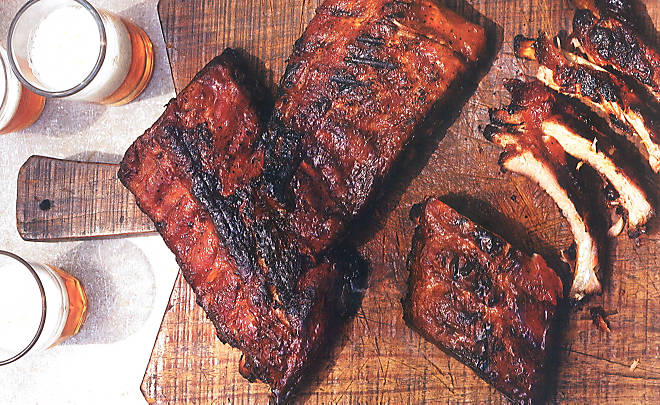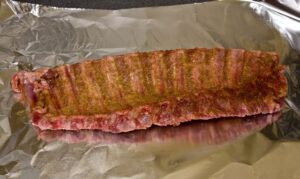
It’s that time of year. The flowers are in bloom, the weather is warm and we’re all excited to get outside after a colder winter than we’ve had in a few years. For me, and a lot of others, spring means BBQ season is open, and it’s time to dust off the smoker, grab some charcoal and wood for smoke, and start the fire.

I have cooked on the most basic backyard smoker, what I call a bullet smoker, a kettle grill equipped to provide indirect heat and competition level smokers. With practice, you can cook great tasting BBQ on any of them. Whatever rig you have, the key is to be able to cook slowly at a low temperature. Lump and briquet charcoal both work well, but briquet is more consistent in temperature and burn time. I do not use charcoal lighter because of the petroleum taste and smell it adds to the pork. A charcoal chimney is the perfect alternative.
For smoke, a little wood goes a long way. It is very easy to “over-smoke” the meat. I like a combination of hickory or pecan and fruit wood—cherry, apple, or peach. Chunks of wood are a great advantage.
Preparation, Fire, and Smoke
While I love a good pulled pork sandwich and brisket, ribs are my favorite. Loin back ribs (“baby backs”) are taken from just beneath the loin and above the spare ribs. St. Louis cut ribs are cut from the spare ribs and have the rib tips removed. Loin back ribs are the leanest and most tender. St. Louis cut ribs are more flavorful but take longer to cook. I’ll use baby backs as an illustration of my cooking process.
 The first step in prepping the ribs is removing the membrane on the bone side of the ribs. It’s easier than it might sound. I insert a butter knife under the membrane along a bone, careful not to tear it, about an inch or so and lift slightly without tearing it. Now, I wrap a paper towel around my index and middle fingers to help grab the membrane and pull it off slowly. If there is excess fat on the ribs, I trim some of it, but I’ll leave some because it provides a lot of flavor.
The first step in prepping the ribs is removing the membrane on the bone side of the ribs. It’s easier than it might sound. I insert a butter knife under the membrane along a bone, careful not to tear it, about an inch or so and lift slightly without tearing it. Now, I wrap a paper towel around my index and middle fingers to help grab the membrane and pull it off slowly. If there is excess fat on the ribs, I trim some of it, but I’ll leave some because it provides a lot of flavor.
Most everyone has a “secret” rub and closely guards its ingredients. However, from backyard cooks to competition teams in Memphis in May’s World Championship Barbecue Cooking Contest, most rubs have a base of paprika, black pepper, salt, garlic and onion powder, brown sugar, and cayenne pepper. Other ingredients that I have used in a rub include chili powder, cumin, coriander, white pepper, parsley, oregano, thyme, rosemary, and raw cane sugar. I apply the rub liberally and make sure it gets worked into the ribs. I let the ribs sit while I prepare the fire.
I want to cook the ribs as close to 225 degrees as possible. After I have added the charcoal to the smoker, I add a chunk of hickory or pecan and a chunk of fruit wood. I also make sure that I have a pan of water above or beside the coals to add moisture to the cooking environment. A trick I picked up from a Memphis in May World Champion is to add halved heads of garlic and onions to the coals for another layer of flavor.
Rib It
Once cooking temperature is reached, I add the ribs, careful to maintain an inch or so space between the racks to allow for airflow, and close the smoker. I want my ribs to take smoke for 2 ½ hours at 225. If the temp starts to drop, have more hot coals ready to add. If you need more water, add it. If you no longer see smoke from the vents, add smaller chunks as need be. You can add beer, wine, or fruit juices to the water pan, but I haven’t found any added benefit to it.
 The next stage is the wrap. I use heavy duty aluminum foil in pieces large enough to enclose the ribs. Take the ribs off the smoker and add hot coals, if necessary, to maintain 225. Slightly pull up all edges of your foil and add a 1/4 cup of apple juice. Sprinkle a tablespoon of raw cane sugar onto the top of the ribs. You can also add a tablespoon or two of butter. Place the ribs meat-side-down in the juice and the same amount of sugar and butter to the bone side of the ribs. Loosely seal the package without the rib bones puncturing the foil. If the foil is punctured, add another wrap of foil. Place the ribs meat-side-down on the grill and close the smoker. You may need to add charcoal and/or water, but we are through with our smoke wood.
The next stage is the wrap. I use heavy duty aluminum foil in pieces large enough to enclose the ribs. Take the ribs off the smoker and add hot coals, if necessary, to maintain 225. Slightly pull up all edges of your foil and add a 1/4 cup of apple juice. Sprinkle a tablespoon of raw cane sugar onto the top of the ribs. You can also add a tablespoon or two of butter. Place the ribs meat-side-down in the juice and the same amount of sugar and butter to the bone side of the ribs. Loosely seal the package without the rib bones puncturing the foil. If the foil is punctured, add another wrap of foil. Place the ribs meat-side-down on the grill and close the smoker. You may need to add charcoal and/or water, but we are through with our smoke wood.
After two hours, remove the ribs from the smoker. Discard the foil and juice. Check the ribs for doneness. If the ribs have pulled slightly back from the bone, great. If not, no worries. I add a little more rub to the top of the ribs and place them back on the grill meat-side-up to cook for another hour at 225. In the last 15 minutes, you can also add your favorite BBQ sauce or finishing glaze. The trend in competitions is for sweeter BBQ to score a little higher but, for myself, I prefer a rib with little more heat than sweet. To check for doneness, lift the rack from the end (use tongs). If the racks bends easily, they are ready. If not, let them go for a little bit longer or until they have reached your preferred level of doneness. Let the ribs rest for about 10 minutes, once you have taken them off the grill. Enjoy!
— Pork Belly Slim, Barbecue Expert
